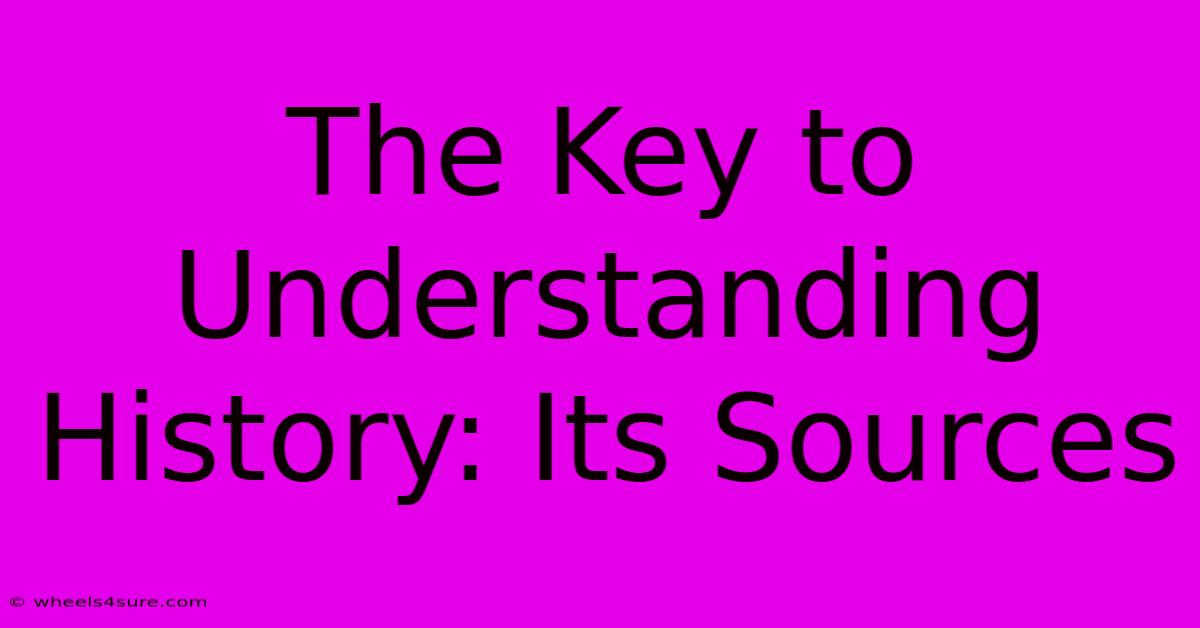The Key To Understanding History: Its Sources

Table of Contents
The Key to Understanding History: Its Sources
History isn't just a collection of dates and names; it's a complex narrative woven from the threads of evidence left behind by the past. Understanding history accurately and critically requires a deep understanding of its sources. These sources, the raw materials of historical inquiry, come in many forms, each with its own strengths and weaknesses. This article will delve into the key types of historical sources and how historians utilize them to construct our understanding of the past.
Primary Sources: Eyewitness Accounts and Artifacts
Primary sources are materials created during the time period being studied. They offer a direct connection to the past, providing firsthand accounts and perspectives. However, it's crucial to remember that even primary sources are not infallible. They can be biased, incomplete, or even deliberately misleading.
Types of Primary Sources:
- Written Documents: These include letters, diaries, official records (government documents, legal papers), newspapers, and literature from the period. For example, analyzing personal letters from soldiers during World War I can provide intimate insights into their experiences.
- Artifacts: These are physical objects from the past, such as tools, weapons, clothing, buildings, and artwork. Examining ancient pottery shards can reveal information about daily life and trade routes.
- Oral Histories: These are firsthand accounts recorded through interviews with individuals who lived through a particular historical event or period. Oral histories are invaluable for understanding perspectives often excluded from written records.
- Images and Visual Media: Photographs, paintings, films, and even maps from the past offer visual perspectives, documenting events and societal norms. Analyzing propaganda posters from World War II can reveal the prevailing ideologies of the time.
Secondary Sources: Interpretations and Analyses
Secondary sources are interpretations and analyses of primary sources. They are created after the historical period under investigation and offer valuable context and perspective. Historians use secondary sources to synthesize information, develop arguments, and offer different interpretations of events. However, it is critical to evaluate the author's biases and methodology.
Understanding Secondary Sources:
- Scholarly Articles and Books: These often provide in-depth analysis and evidence-based arguments. Look for peer-reviewed publications to ensure rigor and quality.
- Biographies and Autobiographies: While offering valuable insights into individual lives, they are subjective accounts and should be critically examined for potential biases.
- Textbooks and Encyclopedias: These provide a broad overview of historical topics but may present simplified or generalized narratives.
Critical Evaluation: The Cornerstone of Historical Inquiry
The process of evaluating historical sources is crucial. Historians employ a range of techniques to determine the reliability and validity of sources. This includes:
- Authorship: Who created the source, and what was their perspective, position, or potential bias?
- Context: When and where was the source created, and what were the surrounding circumstances?
- Content: What information does the source provide, and how does it compare to other sources?
- Intent: What was the purpose of creating the source, and how might this influence its content?
The Importance of Multiple Sources
Relying on a single source is rarely sufficient for a comprehensive understanding of history. Historians often triangulate information by comparing and contrasting multiple sources, looking for patterns and contradictions. This process helps to build a more complete and nuanced picture of the past. By comparing accounts from different perspectives, historians can identify biases and gaps in knowledge.
Conclusion: Building a More Complete Understanding
Understanding the diverse range of historical sources, their strengths and limitations, and the critical evaluation process is essential for comprehending the past. By engaging critically with these sources, we can move beyond simple narratives to a more profound and nuanced understanding of history. This approach fosters a deeper appreciation for the complexity of historical events and the ongoing dialogue surrounding our collective past.

Thank you for visiting our website wich cover about The Key To Understanding History: Its Sources. We hope the information provided has been useful to you. Feel free to contact us if you have any questions or need further assistance. See you next time and dont miss to bookmark.
Featured Posts
-
Lando Norris From Karting To King Of Net Worth
Apr 08, 2025
-
Margot Robbies Unexpected Mom Life
Apr 08, 2025
-
I M The Villains Daughter And I M Taking Back My Life
Apr 08, 2025
-
Shahid Kapoors Age And His Commitment To His Craft
Apr 08, 2025
-
Natasha Jonas Net Worth And Property Holdings
Apr 08, 2025
